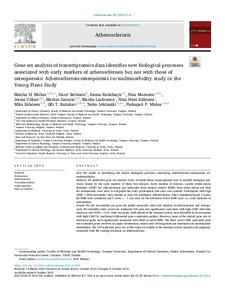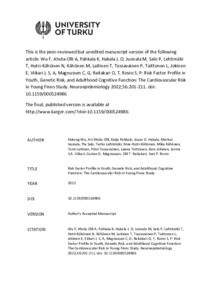Hae
Aineistot 1-10 / 12
Mitochondrial genome-wide analysis of nuclear DNA methylation quantitative trait loci
<p>Mitochondria have a complex communication network with the surrounding cell and can alter nuclear DNA methylation (DNAm). Variation in the mitochondrial DNA (mtDNA) has also been linked to differential DNAm. Genome-wide ...
Economic burden of low physical activity and high sedentary behaviour in Finland
<p><strong>Background</strong> Low physical activity and high sedentary behaviour are unquestionably relevant for public health while also increasing direct and indirect costs.</p><p><strong>Methods</strong> The authors ...
Assessment of plasma ceramides as predictor for subclinical atherosclerosis
<p>Background and aims</p><p>Ceramides have been identified as novel biomarkers for cardiovascular disease (CVD) related events and mortality but their role in etiology of subclinical atherosclerosis is unknown. We aimed ...
Genetic loci and prioritization of genes for kidney function decline derived from a meta-analysis of 62 longitudinal genome-wide association studies
<p>Estimated glomerular filtration rate (eGFR) reflects kidney function. Progressive eGFR-decline can lead to kidney failure, necessitating dialysis or transplantation. Hundreds of loci from genome-wide association studies (GWAS) for eGFR help explain population cross section variability. Since the contribution of these or other loci to eGFR-decline remains largely unknown, we derived GWAS for annual eGFR-decline and meta-analyzed 62 longitudinal studies with eGFR assessed twice over time in all 343,339 individuals and in high-risk groups. We also explored different covariate adjustment. Twelve genome-wide significant independent variants for eGFR-decline unadjusted or adjusted for eGFR-baseline (11 novel, one known for this phenotype), including nine variants robustly associated across models were identified. All loci for eGFR-decline were known for cross-sectional eGFR and thus distinguished a subgroup of eGFR loci. Seven of the nine variants showed variant-by-age interaction on eGFR cross section (further about 350,000 individuals), which linked genetic associations for eGFR-decline with age-dependency of genetic cross-section associations. Clinically important were two to four-fold greater genetic effects on eGFR-decline in high-risk subgroups. Five variants associated also with chronic kidney disease progression mapped to genes with functional in-silico evidence (UMOD, SPATA7, GALNTL5, TPPP). An unfavorable versus favorable nine-variant genetic profile showed increased risk odds ratios of 1.35 for kidney failure (95% confidence intervals 1.03-1.77) and 1.27 for acute kidney injury (95% confidence intervals 1.08-1.50) in over 2000 cases each, with matched controls). Thus, we provide a large data resource, genetic loci, and prioritized genes for kidney function decline, which help inform drug development pipelines revealing important insights into the age-dependency of kidney function genetics.</p>...
Metabolic trajectories in childhood and adolescence: Effects on risk for schizophrenia
<p>Abnormal glucose and lipid metabolism is common in antipsychotic-naive first-episode patients with schizophrenia, but it is unclear whether these changes can already be seen in premorbid or prodromal period, before the first psychotic episode. We examined insulin, total cholesterol, low-density lipoprotein (LDL) cholesterol, high-density lipoprotein (HDL) cholesterol, and triglyceride trajectories in children and adolescents (9-18 years old), who were later diagnosed with schizophrenia, any non-affective psychosis (NAP) or affective disorder (AD). The study population consisted of a general population-based cohort "The Cardiovascular Risk in Young Finns Study", started in 1980 (n=3596). Psychiatric diagnoses were derived from the Health Care Register up to the year 2018. Multivariate statistical analysis indicated no significant differences in insulin or lipid levels in children and adolescents who later developed schizophrenia (n=41) compared to the cohort control group (n=3202). In addition, no changes in these parameters were seen in the NAP (n=74) or AD (n=156) groups compared to the controls, but lower triglyceride levels in childhood/adolescence associated with earlier diagnosis of psychotic disorder in the NAP group. Taken together, our results do not support any gross-level insulin or lipid changes during childhood and adolescence in individuals with later diagnosis of schizophrenia-spectrum disorder. Since changes in glucose and lipid metabolism can be observed in neuroleptic-naive patients with schizophrenia, we hypothesize that the more marked metabolic changes develop during the prodrome closer to the onset of the first psychotic episode. The findings have relevance for studies on developmental hypotheses of schizophrenia.</p>...
Repeatedly Measured Serum Creatinine and Cognitive Performance in Midlife: The Cardiovascular Risk in Young Finns Study
<p><strong>Background and Objectives</strong> Serum creatinine is typically used to assess kidney function. Impaired kidney function and thus high serum creatinine increase the risk of poor cognitive performance. However, ...
Gene set analysis of transcriptomics data identifies new biological processes associated with early markers of atherosclerosis but not with those of osteoporosis: Atherosclerosis-osteoporosis co/multimorbidity study in the Young Finns Study
<p>Aim<br></p><p>We aimed at identifying the shared biological processes underlying atherosclerosis-osteoporosis co/multimorbidity.</p><p>Methods</p><p>We performed gene set analysis (GSA) of whole-blood transcriptomic ...
Associations of parental physical activity trajectories with offspring's physical activity patterns from childhood to middle adulthood: The Young Finns Study
We investigated the association of parental physical activity (PA) trajectories with offspring's youth and adult PA. Self-reported PA data were extracted from the Young Finns Study with three follow-ups for parents between ...
Risk Factor Profile in Youth, Genetic Risk, and Adulthood Cognitive Function: The Cardiovascular Risk in Young Finns Study
<p>INTRODUCTION</p><p>The role of risk factor profile in childhood and adolescence on adulthood cognitive function and whether it differs by genetic risk is still obscure. To bring this evidence, we determined cognitive ...
Obesity during childhood is associated with higher cancer mortality rate during adulthood: the i3C Consortium
<p><b>Background: </b>In high-income countries, cancer is the leading cause of death among middle-aged adults. Prospective data on the effects of childhood risk exposures on subsequent cancer mortality are scarce. ...








